Class 10th Science - Human Eye and the Colourful World Case Study Questions and Answers 2022 - 2023
By QB365 on 09 Sep, 2022
QB365 provides a detailed and simple solution for every Possible Case Study Questions in Class 10th Science Subject - Human Eye and the Colourful World, CBSE. It will help Students to get more practice questions, Students can Practice these question papers in addition to score best marks.
QB365 - Question Bank Software
Human Eye and the Colourful World Case Study Questions With Answer Key
10th Standard CBSE
-
Reg.No. :
Science
-
A prism is a transparent refracting medium bounded by two plane surfaces inclined to each other at a certain angle. The refraction of light through a prism follows the laws of refraction. In the prism, refraction takes place on its refracting surface it means when the light enters the prism and when the light leaves the prism. The refraction through a prism is shown. Here, A is the angle of prism, \(\angle\)i is the angle of incidence of the face AB and \(\angle\)e is the angle of emergence at other face AC.
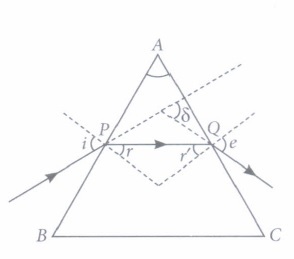
The incident ray suffers a deviation or bending through an angle \(\begin{equation} \delta \end{equation}\) due to the refraction through prism. This angle is called angle of deviation as shown in figure.
\(\angle\)i + \(\angle\)e = \(\angle\)\(\begin{equation} \delta \end{equation}\) + \(\angle\)A
(i) The angle between the two refracting surfaces of a prism is called(a) angle of prism (b) angle of incidence (c) angle of deviation (d) angle of emergence (ii) The angle between the incident ray and the emergent ray is called
(a) angle of emergence (b) angle of deviation (c) angle of incidence (d) none of these (iii) When a ray is refracted through a prism, then
(a) \(\angle\)i=\(\angle\)\(\begin{equation} \delta \end{equation}\) (b) \(\angle\) i=\(\angle\)e+\(\angle\)\(\begin{equation} \delta \end{equation}\) (c) \(\angle\)\(\begin{equation} \delta \end{equation}\)= \(\angle\)e (d) \(\angle\)i > \(\angle\)r (iv) The angle of deviation depends on
(a) refractive index of prism (b) angle of incidence (c) both (a) and (b) (d) none of these (v) The rectangular surfaces of a prism are known as
(a) reflecting surfaces (b) dispersing surfaces (c) refracting surfaces (d) none of these. (a) -
When white light is incident on one refracting surface of the prism, the light splits up into constituent colours violet, indigo, blue, green, yellow, orange and red. The process of splitting of white light into its seven constituent colours is called dispersion. When the dispersed white light is made to fall on a screen, we get the band of seven colours is called the spectrum of white light. Red colour bends the least on passing through the prism and violet colour bends through maximum angle on passing through the prism.
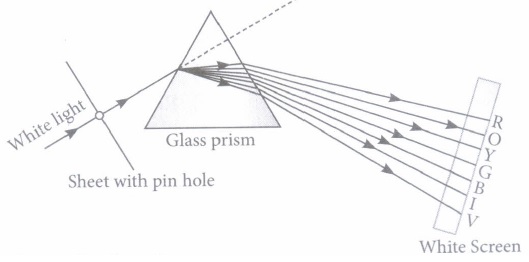
(i) The splitting of white light can be done by(a) lens (b) prism (c) mirror (d) none of these (ii) Which property of light is used by prism to form a spectrum?
(a) Reflection (b) Refraction (c) Dispersion (d) Scattering (iii) Which of the following dispersion is correct?
(a) 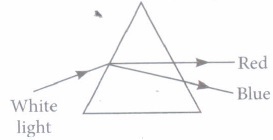
(b) 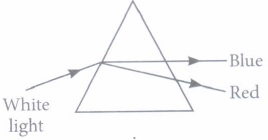
(c) 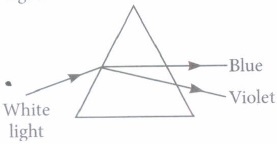
(d) 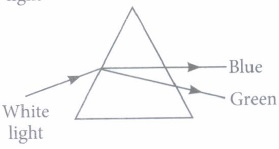
(iv) When a red light passes through a prism, it
(a) will not split
(b) will split into seven colours
(c) will split into white colour
(d) will split into many different colours.
(v) The spectrum produced by the white light by a prism is called(a) pure spectrum (b) impure spectrum (c) monochromatic spectrum (d) none of these. (a) -
Light of all the colour travel at the same speed in vacuum for all wavelengths. But in any transparent medium
(glass or water), the light of different colours travel with different speeds for different wavelength that means
that the refractive index of a particular medium is different for different wavelength. As there is a difference in
their speeds, the light of different colour bend through different angles. The speed of violet colour is maximum and the speed of red colour is minimum in glass so, the red light deviates least and violet colour deviates most.
Hence, higher the wavelength of a colour of light, smaller the refractive index and less is the bending of light.
\(\begin{equation} \lambda \end{equation}\)r > \(\begin{equation} \lambda \end{equation}\)v and rn < vn, \(\begin{equation} v=\frac{c}{\lambda} . \end{equation}\)
(i) Which of the following statements is correct regarding the propagation of light of different colours of white light in air?
(a) Red light moves fastest.
(b) Blue light moves faster than green light.
(c) All the colours of the white light move with the same speed.
(d) Yellow light moves with the mean speed as that of the red and the violet light.
(ii) Which of the following is the correct order of wavelength?(a) Red> Green> Yellow (b) Red> Violet> Green (c) Yellow> Green> Violet (d) Red> Yellow> Orange (iii) Which of the following is the correct order of speed of light in glass?
(a) Red> Green> Blue (b) Blue> Green> Red (c) Violet> Red> Green (d) Green> Red> Blue (iv) Which colour which has maximum frequency
(a) Red (b) Violet (c) Blue (d) Green (v) Which of the following is the correct order of angle of deviation?
(a) Red> Green> Blue (b) Blue> Yellow> Orange (c) Orange> Red> Green (d) Blue> Green> Violet (a) -
The spreading of light by the air molecules is called scattering of light. The light having least wavelength scatters more. The sun appears red at sunrise and sunset, appearance of blue sky it is due to the scattering of light. The colour of the scattered light depends on the size of particles. The smaller the molecules in the atmosphere scatter smaller wavelengths of light. The amount of scattering of light depends on the wavelength of light. When light from sun enters the earth's atmosphere, it gets scattered by the dust particles and air molecules present in the atmosphere. The path of sunlight entering in the dark room through a fine hole is seen because of scattering of the sun light by the dust particles present in its path inside the room.
(i) To an astronaut in a spaceship, the colour of earth appears(a) red (b) blue (c) white (d) black (ii) At the time of sunrise and sunset, the light from sun has to travel.
(a) longest distance of atmosphere
(b) shortest distance of atmosphere
(c) both (a) and (b)
(d) can't say
(iii) The colour of sky appears blue, it is due to the
(a) refraction oflight through the atmosphere
(b) dispersion of light by air molecules
(c) scattering of light by air molecules
(d) all of these.
(iv) At the time of sunrise and sunset
(a) Blue colour scattered and red colour reaches our eye
(b) Red colour scattered and blue colour reaches our eye
(c) Green and blue scattered and orange reaches our eye
(d) None of these
(v) The danger signs made red in colour, because
(a) the red light can be seen from farthest distance
(b) the scattering of red light is least
(c) both (a) and (b)
(d) none of these(a) -
Atmospheric refraction is the phenomenon of bending of light on passing through earth's atmosphere. As we move above the surface of earth, density of air goes on decreasing. Local conditions like temperature etc. also affect the optical density of earth's atmosphere. On account of atmospheric refraction, stars seen appear higher than they actual are; advanced sunrise; delayed sunset, oval appearance of the sun at sunrise and sunset; stars twinkle, planets do not.
(i) Due to atmospheric refraction, apparent length of the day(a) increases (b) decreases (c) remains the same (d) all of these (ii) Apparent position of the star appears raised due to
(a) atmospheric refraction (b) scattering of light (c) both (a) and (b) (d) none of these (iii) The sun appears oval shaped or flattened due to
(a) dispersion (b) scattering (c) atmospheric refraction (d) cannot say (iv) Twinkling of stars and non-twinkling of planets is accounted for by
(a) scattering of light (b) dispersion of light (c) atmospheric refraction (d) none of these (v) In absence of atmosphere, the colour of sky appears
(a) blue (b) black (c) red (d) yellow (a) -
Dispersion is the splitting up of white light into seven colors on passing through a transparent medium like a glass prism. When a white light beam is passed through a prism, a band of seven colors are formed is known as spectrum of white light as shown in below figure.
When white light consisting of seven colors falls on a transparent medium (glass prism) , each color in it is refracted ( or deviated ) by a different angle , with the result that seven colors are spread out to form a spectrum
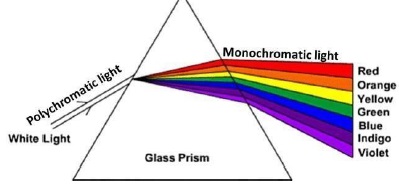
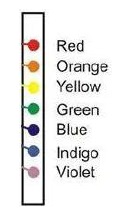
(i) A beam of white light falls on a glass prism. The colour of light which undergoes the least bending on passing through the glass prism is :(a) violet (b) red (c) green (d) blue (ii) The colour of white light which suffers the maximum bending (or maximum refraction) on passing through a glass prism is :
(a) yellow (b) orange (c) red (d) violet (iii) Which of the following colour of white light is least deviated by the prism ?
(a) green (b) violet (c) indigo (d) yellow (iv) The colour of white light which is deviated the maximum on passing through the glass prism is :
(a) blue (b) indigo (c) red (d) orange (v) The splitting up of white light into seven colours on passing through a glass prism is called :
(a) refraction (b) deflection (c) dispersion (d) scattering (a) -
The twinkling of a star is due to atmospheric refraction of starlight. The starlight on entering the earth's atmosphere, undergoes refraction continuously before it reaches the earth. The atmospheric refraction occurs in a medium of gradually changing refractive index. Since the atmosphere bends starlight towards the normal, the apparent position of the star is slightly different from its actual position. The star appears slightly higher than its actual position when viewed near the horizon. Further this apparent position of the star is not stationary, but keeps on changing slightly, since the physical conditions of the earth's atmosphere are not stationary. Since the stars are very distant they are approximate point-sized source of light. As the path of rays of light coming from the star goes on varying slightly, the apparent position of the star fluctuates and the amount of starlight entering the eye flickers the stars sometimes appear brighter and at some other time, fainter, which is the twinkling effect.
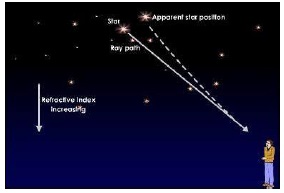
(i) The stars seem higher than they actually are due to :(a) Reflection of light (b) Refraction of light (c) Scattering of light (d) Inference of light (ii) Stars appear to twinkle because of :
(a) Atmospheric refraction (b) Movement of air (c) Both (a) and (b) (d) None of these (iii) At noon the Sun appears white as :
(a) Light is least scattered
(b) All the colours of the white light are scattered away
(c) Blue colour is scattered the most
(d) Red colour is scattered the most
(iv) Which of the following phenomena of light is involved in the formation of rainbow?
(a) Reflection, refraction and dispersion
(b) Refraction, dispersion and total internal reflection
(c) Refraction, dispersion and internal reflection
(d) Dispersion, scattering and total internal reflection
(v) Which of the following statements is correct regarding the propagation of light of different colours of white light in air?
(a) Red light moves with the fastest speed
(b) Blue light moves faster than green light
(c) All the colours of the white light move with the same speed.
(d) Yellow light moves with the mean speed as that of the red and the violet light
(a)
Case Study
*****************************************
Answers
Human Eye and the Colourful World Case Study Questions With Answer Key Answer Keys
-
(i) (a): The angle between the two refracting surfaces of a prism is called angle of prism.
(ii) (b): The angle between the incident ray and the emergent ray is called angle of deviation.
(iii) (d): As the ray of light enters from rarer medium (air) to denser medium (glass), the angle of incidence is more than angle of refraction.
(iv) (c): More be the refractive index, more be the angle of deviation and it also depends on the refractive index of prism.
(v) (c): The refraction of light takes place through rectangular surfaces. -
(i) (b)
(ii) (b)
(iii) (a): The deviation is maximum for violet and minimum for red, so option (a) is correct.
(iv) (a): The red light has a single wavelength and when enters a prism, it will not split into other different colours.
(v) (b): The boundaries of colours in the spectrum produced by prism are not sharp, so the spectrum is impure. -
(i) (c): All the colours of the white light move with the same speed in air.
(ii) (c): The increasing order of wavelength of visible spectrum is
Violet < Indigo < Blue < Green < Yellow < Orange < Red
So, the correct order is
Yellow> Green> Violet
(iii) (b): The more be the wavelength, more be the speed.
(iv) (b): Frequency is inversely proportional to the wavelength. Violet has minimum wavelength among all these colours, so violet has maximum frequency.
(v) (b): The angle of deviation is more for more refractive index. -
(i) (b): Light is scattered by the air molecules present in atmosphere.
(ii) (a): As the distance between us and sun is more at the time of sunrise and sunset.
(iii) (c) : Due to the more scattering of blue colour by molecules of air.
(iv) (a): Red light being of largest wavelength blue scatter more, red scattered least.
(v) (c): Scattering is least but velocity of red light is more. -
(i): Due to atmospheric refraction, apparent length of the day increases by 4 minutes.
(ii) (a): Apparent position of the star appears raised due to atmospheric refraction.
(iii) (c)
(iv) (c): Twinkling of stars and non-twinkling of planets is on account of atmospheric refraction.
(v) (b): Due to no scattering of light. -
(i) (b) red
(ii) (d) violet
(iii) (d) yellow
(iv) (b) indigo
(v) (c) dispersion -
(i) (b) Refraction of light
(ii) (c) Both (a) and (b)
(iii) (a) Light is least scattered
(iv) (c) Refraction, dispersion and internal reflection
(v) (c) All the colours of the white light move with the same speed.
Case Study

























